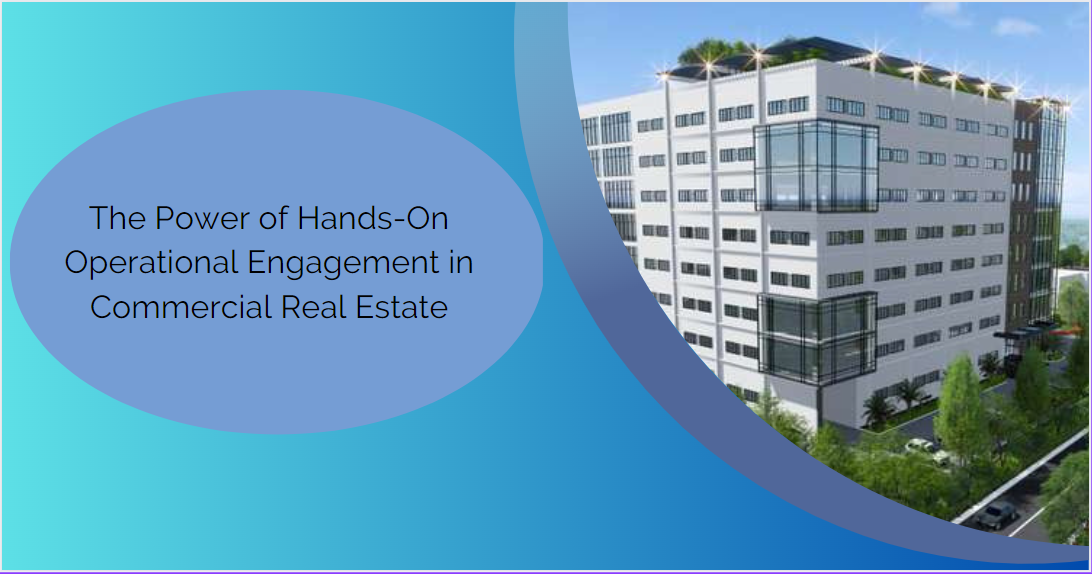When we think about commercial real estate, we often consider financial metrics, market trends, property types, and location dynamics. However, one game-changing strategy often overlooked in this context is hands-on operational engagement. A real estate investor who actively engages in the day-to-day operations of a property can potentially unlock exceptional returns and enjoy a competitive edge.
Hands-on operational engagement is a proactive, immersive approach to property management that extends beyond mere oversight. It's about understanding the nitty-gritty details that can make or break a property’s profitability, enhancing tenant satisfaction, and positively influencing the property's net operating income.
Enhancing Asset Value
Active asset or operational engagement can significantly increase the value of a commercial property. It involves taking a granular look at the property, identifying areas of improvement, implementing changes, and continuously monitoring and adjusting operations.
For instance, consider energy-efficiency upgrades. They may seem insignificant, but they can substantially reduce utility costs, thereby increasing the net operating income and, in turn, the asset value. Only a hands-on investor, keenly observing the property’s operation, can identify such opportunities for strategic improvements.
Boosting Tenant Satisfaction and Retention
Tenants are at the heart of commercial real estate’s success. A hands-on approach fosters a strong landlord-tenant relationship, as the investor is aware of tenants' needs and can proactively address them. Satisfied tenants are more likely to renew their leases and more likely to accept rent increases, contributing to the property’s revenue growth and stability.
Risk Mitigation
Hands-on operational engagement also plays a crucial role in risk management. Frequent property inspections can identify potential problems before they become significant issues, such as maintenance requirements or security concerns. Additionally, an investor who understands the property's operations can better forecast operational costs, which aids in accurate financial planning and budgeting.
Adaptability
Finally, hands-on operational engagement allows syndicators to adapt swiftly to market changes. By being closely involved, investors can identify and leverage emerging trends, whether it's a rising demand for coworking spaces or new health and safety standards in response to a global pandemic.
Embracing hands-on operational engagement requires commitment, time, and patience. It involves creating systems and procedures for consistent performance, training and managing teams for efficient execution, and leveraging technology to streamline operations. While it's demanding, the benefits it yields – increased asset value, tenant satisfaction, risk mitigation, and adaptability – make it an essential strategy for most successful commercial real estate investors.
In a nutshell, hands-on operational engagement or asset management is an incredibly powerful tool that transforms a commercial real estate investor from a passive investor into a proactive, strategic asset manager. It’s the secret sauce that can turbocharge the returns of your real estate portfolio. So roll up your sleeves and dive into the day-to-day workings of your property – your bottom line will thank you.
Strategic Repositioning and Recapitalization: The Golden Keys to Unlocking Maximum Returns in Commercial Real Estate
In the ever-evolving landscape of commercial real estate (CRE), the quest to maximize returns on your investment demands a forward-thinking, adaptive strategy. Among the many investment considerations, two strategies stand out as vital cornerstones of successful CRE investing, strategic repositioning and recapitalization. In this post, we'll discuss how these powerful strategies can bolster your CRE portfolio, unlocking powerful growth and returns.
Repositioning in the CRE realm is analogous to breathing new life into a property. It involves fundamentally changing the property's character or function to enhance its market value and improve financial performance. This might include renovations, new tenant mix, upgrading amenities, or even a change of use.
For instance, consider an old warehouse in an area that has lately seen a surge of trendy restaurants and boutiques. Repositioning might involve converting this warehouse into a retail destination or a chic co-working space, aligning it with the neighborhood's shifting demographics.
Strategic repositioning demands an intimate understanding of the local market, emerging trends, and consumer preferences. With successful execution, it can catapult the property's appeal, generate increased revenue, and ultimately boost your returns.
Next, let's delve into recapitalization. This is a financial strategy that adjusts a company's capital structure, usually through debt restructuring or equity infusion. Essentially, recapitalization modifies the debt and equity ratio in the business, thereby influencing its risk and return profile.
Recapitalization in commercial real estate can serve multiple goals. It may help reduce debt, finance property improvements, or allow the original investors to cash out partially or fully. It can also be a lifeline for properties struggling to stay afloat, providing them with the much-needed financial cushion.
For instance, a shopping mall hit hard by the e-commerce boom may leverage recapitalization to fund a transformation into a multi-use property with residential, office, and retail spaces. By doing so, the mall can draw a steady stream of income from diverse sources and counterbalance the impact of declining retail sales.
Critically, recapitalization can alter a property's financial risk, potentially improving its appeal to investors. Furthermore, it can result in higher property values, which directly translate into increased returns for you as an investor.
To successfully execute strategic repositioning and recapitalization, collaboration with seasoned professionals in real estate, finance, and legal domains is often required. This collaborative effort can ensure an optimal blend of market knowledge, financial acumen, and legal expertise, setting the stage for a profitable venture.
In our journey through commercial real estate, we've learned that success doesn't always come from doing things the traditional way. It comes from being flexible, adaptable, and open to new ideas. We've seen how strategic repositioning can completely transform a property, and recapitalization can revitalize a struggling property. Embrace these strategies and unlock the true potential of your commercial real estate portfolio. Don’t miss out on more insights to improve your CRE investment strategies. Subscribe, share, and join the conversation today!


